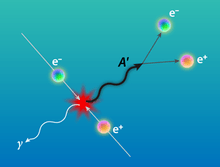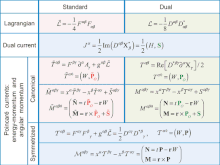Dual photon
| Composition | Elementary particle |
|---|---|
| Statistics | Bosonic |
| Interactions | Electromagnetic |
| Status | Hypothetical |
| Theorized | 2000s[1][2][3][4][5] |
| Electric charge | 0 e |
| Spin | 1 |
| String theory |
|---|
 |
| Fundamental objects |
| Perturbative theory |
| Non-perturbative results |
| Phenomenology |
| Mathematics |
|
Theorists
|
In theoretical physics, the dual photon is a hypothetical elementary particle that is a dual of the photon under electric-magnetic duality which is predicted by some theoretical models[3][4][5] and some results of M-theory in eleven dimensions.[1][2]
It has been shown that including magnetic monopole in Maxwell's equations introduces a singularity. The only way to avoid the singularity is including a second four-vector potential, called dual photon, in addition to the usual four-vector potential, photon.[6] Additionally, it was found that the standard Lagrangian of electromagnetism is not dual symmetric that causes dual-asymmetric problems of the energy–momentum, spin and orbital angular-momentum tensors. To resolve this issue, a dual-symmetric Lagrangian of electromagnetism has been proposed,[3] which has a self-consistent separation of the spin and orbital degrees of freedom. The Poincaré symmetries imply that the dual electromagnetism naturally makes self-consistent conservation laws.[3]
Dual electromagnetism
The free electromagnetic field is described by a covariant antisymmetric tensor of rank 2 by
where is the electromagnetic potential.
The dual electromagnetic field is defined as
where denotes the Hodge dual, and is the Levi-Civita tensor
For both the electromagnetic field and its dual field, we have
Then, for a given gauge field , the dual configuration is defined as [2]
where the field potential of the dual photon, and non-locally linked to the original field potential .
p-form electrodynamics
A p-form generalization of Maxwell's theory of electromagnetism is described by a gauge invariant 2-form defined as
- .
which satisfies the equation of motion
where is the Hodge dual.
This implies the following action in the spacetime manifold :[7][8]
where is the dual of the gauge invariant 2-form for the electromagnetic field.
Dark photon

The dark photon is a spin-1 boson associated with a U(1) gauge field, which could be massless[10] and behaves like electromagnetism. But, it could be unstable and massive, quickly decays into electron-positron pairs, and interact with electrons.
The dark photon was first suggested in 2008 by Lotty Ackerman, Matthew R. Buckley, Sean M. Carroll, and Marc Kamionkowski to explain the 'g–2 anomaly' in experiment E821 at Brookhaven National Laboratory,.[11] Nevertheless, it was ruled out in some experiments such as the PHENIX detector at the Relativistic Heavy Ion Collider at Brookhaven.[12]
In 2015, the Hungarian Academy of Sciences's Institute for Nuclear Research in Debrecen, Hungary, suggested the existence of a new, light spin-1 boson, 34 times heavier than the electron[13] that decays into a pair of electron and positron with a combined energy of 17 MeV. In 2016, it was proposed that it is a X-boson with a mass of 16.7 MeV that explains m-2 muon anomaly.[13][14]

See also
References
- 1 2 Tong, D.; Lambert, N. (2008). "Membranes on an Orbifold". Physical Review Letters. 101: 041602. arXiv:0804.1114. Bibcode:2008PhRvL.101d1602L. doi:10.1103/PhysRevLett.101.041602.
- 1 2 3 Bakas, I. (2010). "Dual photons and gravitons". Publ.Astron.Obs.Belgrade. 88: 113–132. arXiv:0910.1739. Bibcode:2010POBeo..88..113B.
- 1 2 3 4 5 Bliokh, K. Y.; Bekshaev, A. Y.; Nori, F. (2013). "Dual electromagnetism: helicity, spin, momentum and angular momentum". New Journal of Physics. 15 (3): 033026. arXiv:1208.4523. Bibcode:2013NJPh...15c3026B. doi:10.1088/1367-2630/15/3/033026.
- 1 2 Elbistan, M.; Duval, C.; Horváthy, P. A.; Zhang, P.-M. (2016). "Duality and helicity: A symplectic viewpoint". Physics Letters B. 761: 265–268. arXiv:1608.01131. Bibcode:2016PhLB..761..265E. doi:10.1016/j.physletb.2016.08.041.
- 1 2 Elbistan, M.; Horváthy, P. A.; Zhang, P.-M. (2017). "Duality and helicity: the photon wave function approach". Physics Letters A. 381 (30): 2375–2379. arXiv:1608.08573. Bibcode:2017PhLA..381.2375E. doi:10.1016/j.physleta.2017.05.042.
- ↑ Singleton, D. (1996). "Electromagnetism with magnetic charge and two photons". American Journal of Physics. 64 (4): 452–458. arXiv:1106.1505. Bibcode:1996AmJPh..64..452S. doi:10.1119/1.18191.
- ↑ Henneaux, M.; Teitelboim, C. (1986). "p-Form electrodynamics". Foundations of Physics. 16 (7): 593–617. Bibcode:1986FoPh...16..593H. doi:10.1007/BF01889624.
- ↑ Henneaux, M.; Bunster, C. (2011). "Action for twisted self-duality". Physical Review D. 83 (12): 125015. arXiv:1103.3621. Bibcode:2011PhRvD..83l5015B. doi:10.1103/PhysRevD.83.125015.
- ↑ "Viewpoint: New Light Shed on Dark Photons" (Press release). American Physical Society. 10 November 2014.
- ↑ Carroll, Sean M. (October 29, 2008). "Dark photons". Retrieved 23 February 2015.
- ↑ Bennett, G. W.; Bousquet, B.; Brown, H. N.; Bunce, G.; Carey, R. M.; Cushman, P.; Danby, G. T.; Debevec, P. T. (2006-04-07). "Final report of the E821 muon anomalous magnetic moment measurement at BNL". Physical Review D. 73 (7): 072003. arXiv:hep-ex/0602035. Bibcode:2006PhRvD..73g2003B. doi:10.1103/PhysRevD.73.072003.
- ↑ Walsh, Karen McNulty (February 19, 2015). "Data from RHIC, other experiments nearly rule out role of 'dark photons' as explanation for 'g-2' anomaly". PhysOrg. Retrieved 23 February 2015.
- 1 2 Cartlidge, Edwin. "Has a Hungarian physics lab found a fifth force of nature?". Nature. doi:10.1038/nature.2016.19957.
- ↑ Feng, J. L.; Fornal, B.; Galon, I.; Gardner, S.; Smolinsky, J.; Tait, T. M. P.; Tanedo, P. (2016). "Protophobic Fifth-Force Interpretation of the Observed Anomaly in 8Be Nuclear Transitions". Physical Review Letters. 117 (7): 071803. arXiv:1604.07411. Bibcode:2016PhRvL.117g1803F. doi:10.1103/PhysRevLett.117.071803.

